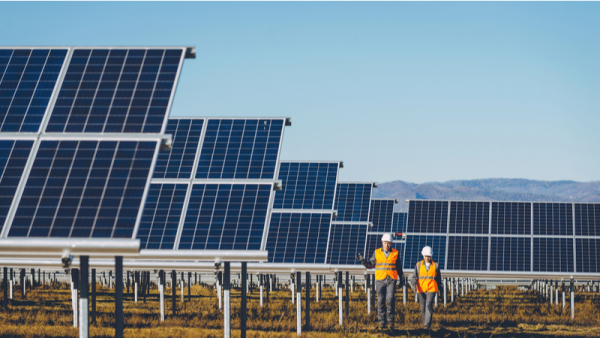Solar power can help solve China’s coal power dilemma
Mark Agnor / Shutterstock

Muyi Yang, Adjunct Fellow, Australia-China Relations Institute, University of Technology Sydney |

Xunpeng Shi, Principal Research Fellow, Australia-China Relations Institute, University of Technology Sydney |
| Peng Wang, Researcher, Guangzhou Institute of Energy Conversion, Chinese Academy of Sciences |
This article appeared in Energy Tracker Asia on October 5 2021.
Despite the pledge to attain carbon neutrality before 2060, China’s coal generation has continued to expand, up 337 TWh or 15 percent in the first half of 2021 from the pre-pandemic level, according to a recent report from Ember. Some may conceive this surge in coal generation as new evidence to support the argument that ‘China talks more but does less’. However, the potency of this viewpoint begins to wither away when considered alongside the recent drop in coal power investment, especially after April 2021, as the central government sought to rein in coal-power growth.
This blog provides an alternative view on China’s recent surge in coal generation, arguing that this happens as rising electricity demand outpaces growth in clean power. However, with coal prices hitting record highs, this also puts China’s power companies in a dilemma between pressure to meet rising needs for electricity and growing financial difficulties caused by their loss-making coal-fired power plants. Stable-cost solar power provides an attractive solution for this dilemma.
Pressure to meet rising electricity needs pushes up coal power
China’s electricity demand rose by 14 percent in the first half of 2021, compared to the same period in 2019, when the pandemic had not yet affected the country, according to Ember’s analysis of electricity statistics published by the China Electricity Council (CEC).
The same period also witnessed a considerable rise in generation from ‘clean’ energy sources: 22 percent for nuclear, 44 percent for solar, and 45 percent for wind. This rise, though impressive, was only able to meet approximately 40 percent of the incremental electricity demand. This, together with a less-than-expected hydro generation, pushed up China’s coal generation, leading to higher operating hours of coal capacity (up 254 hours from the previous year) – a reverse of the declining trends in recent years.
China’s power companies in financial distress
China’s surge in coal power put many generators under growing financial pressure, as coal prices hit record highs this year. Currently, the country’s electricity prices are determined via a ‘base price + floating (up or down)’ mechanism, in which the floating range can either go 10 percent above or 15 percent below the base price. However, prices were not allowed to go above the base price in 2020, which was later extended into 2021 as a temporary measure to ensure price stability for commercial and industrial consumers. This means that generators (or energy retailers) will bear most of the costs associated with rising coal prices and cannot pass through these costs to the end-users.
The costs of purchasing coal for some large generating companies in China increased by 50.5 percent in June this year, a report by China Electricity Council has found. This cost hike put many generating companies under pressure to stay afloat. Wang Ke, a researcher at Renmin University of China, said in an interview with China Energy News that nearly 60.6 percent of the coal-fired power plants in China made a loss.
In some regions where wholesale markets for electricity trading have been established, the spot prices soared in the first half of 2021, reflecting the rising costs of coal power. However, energy retailers in the markets cannot pass through the high spot prices to the end-users due to the presence of price controls (i.e., no upward floating). This caused huge financial losses for these companies, and some were even on the verge of bankruptcy.
Of the 142 energy retailers in the Guangdong electricity market, only 19 made a profit in the first half of 2021, according to a report by the market operator, Guangdong Power Exchange Center. In June this year, several energy retailers jointly sent a letter to the Guangdong government, asking to suspend market trading under growing financial pressure. Similar phenomena have also been observed in other electricity markets across the country.
Solar power: An attractive solution for China’s coal power dilemma
China’s power companies are in a coal power dilemma: meeting energy needs despite financial woes. Solar power can be an attractive option for redressing this dilemma. Once it is built, solar power has specific and predictable cost profiles involving mainly operating and maintenance costs, whereas the cost profiles for coal power are often affected by volatile fuel prices.
China’s recent ramp-up of policy support for rooftop solar PV further vindicates the practicality of this option. National Energy Administration (NEA) – the national energy policymaker and planner – issued a document in July this year that sets up a rooftop PV mandate for selected counties: at least 20 percent of all residential rooftops; at least 30 percent of commercial and industrial buildings; more than 40 percent of non-government public buildings, such as schools and hospital; and over 50 percent of government buildings.
This signals a policy shift towards a more inclusive approach to electricity decarbonisation in China that goes beyond utility-scale projects to include small-scale technologies, like rooftop solar PV, which have historically received less attention. This approach could help ramp up clean power, and alongside a significant efficiency improvement, contribute to closing the gap between rising needs for electricity and the supply capacity of clean power – essential for a timely and orderly phase-out of coal power.
Besides this policy shift, reconfiguring of the power system, encompassing all its constitutive elements (e.g., market mechanisms, network infrastructure, and regulatory processes), should also speed up to accommodate large outputs from variable distributed renewable sources, while maintaining supply sufficiency and reliability. The financial difficulties recently experienced by many power companies in China provide additional stimulus for these changes.
Through embracing cost-stable solar power, a net-zero power system could emerge more smoothly and rapidly in China.
Authors
Dr Muyi Yang is a researcher at the Australia-China Relations Institute, University of Technology Sydney.
Associate Professor Xunpeng Shi is Principal Research Fellow at the Australia-China Relations Institute, University of Technology Sydney.
Assistant Professor Peng Wang is a Researcher at the Guangzhou Institute of Energy Conversion, Chinese Academy of Sciences.

